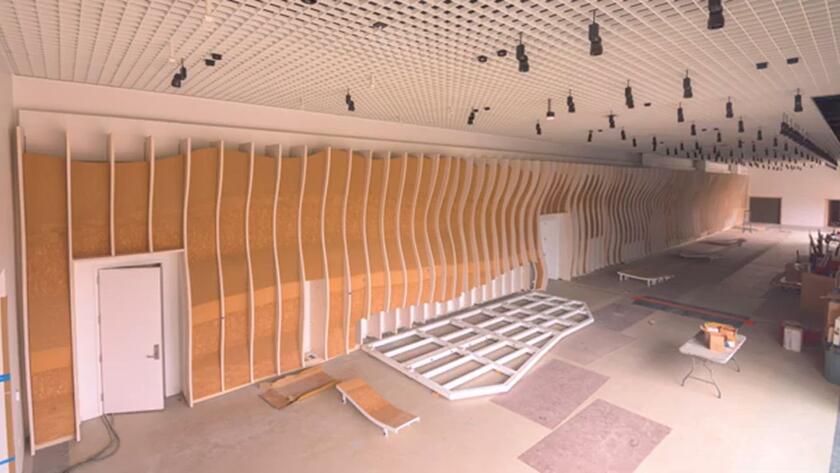
- Share via
- The fossilized remains of a previously unknown species of dinosaur were discovered in Utah.
- Due to a chemical reaction over millennia, the fossils turned green.
- The herbivore, 75 feet long, will go on display at the Natural History Museum of Los Angeles County.
150 million years ago: Laurasia
The massive neck dips, casting a curving shadow on the mossy ground. The dinosaur’s jaws close around its prize. The creature lifts its head, nearly dainty in scale, and contentedly gnaws a mouthful of ferns.
It’s the late Jurassic Period in the supercontinent of Laurasia, some 85 million years into the reign of the dinosaurs. The animal belongs to a herd of hefty herbivores who spend their days lumbering through an open landscape of conifers and gingkos, horsetails and monkey puzzle trees.


It’s 10 tons at least, far longer than it is tall, its seemingly endless neck and tail held parallel to the ground in surprisingly delicate balance.
Stubby ankylosaurs graze in the distance; carnivorous allosaurs stalk for prey. Tiny mammals scamper out of the path of its thunderous footsteps.
One day the dinosaur will have a name: Gnatalie. One day it will crisscross continents that don’t yet exist, coming to rest in the Natural History Museum of Los Angeles County.
But all that is a long way off. On this day in prehistory, Los Angeles still lies beneath a shallow sea.
This far back in time, some details are too fuzzy to make out. We don’t know the dinosaur’s sex. We don’t know how it dies: illness or injury, predators or old age. But we know it lives three or four decades, and eventually the day comes when the dinosaur falls and does not rise again for many, many years.
- Share via
A hungry ecosystem devours its flesh and muscle. Rains come and the dinosaur’s bones wash into a river, where they lodge in the sandy bottom. Flowing water covers them in thin blankets of silt.
This is just the beginning.
80 million to 50 million years ago: Laramidia
Above ground, things live and die and disappear. But the dinosaur, encased in layers of sediment, is exempt from this endless cycle of growth and decay.
Millennia tick past. Those layers of soil compress into rock studded with the remains of forgotten creatures. More time goes by, and as the organic material in the bones wears away, water seeps into its place from the surrounding rock.
The water carries minerals, and with enough time — tens of thousands of years, or millions — mineral deposits fill up the bone-shaped cavities in the rock, creating perfect replicas of teeth that once chewed ferns and tibia that held up a giant.
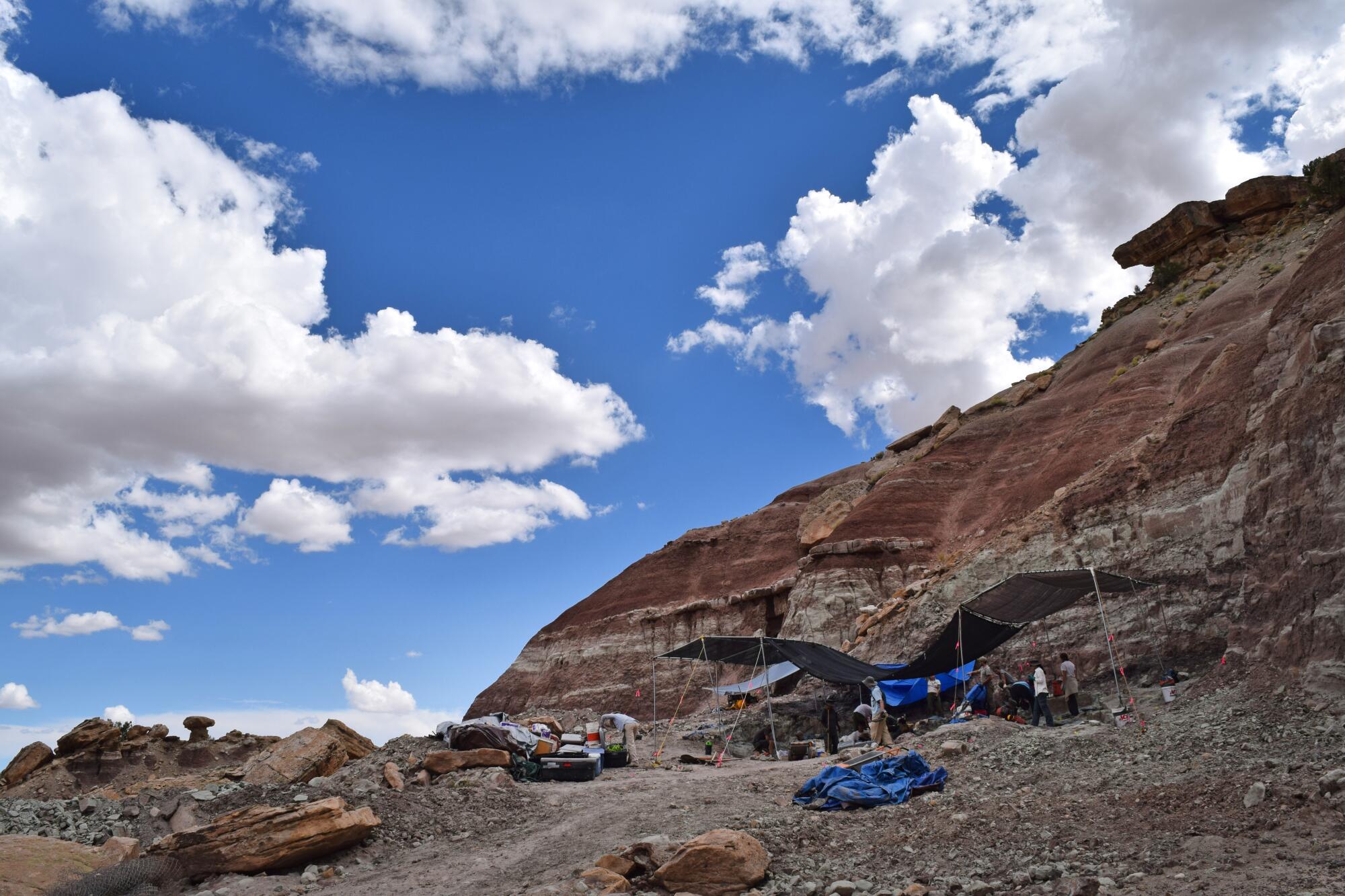
Volcanoes set off a cascade of chemical changes in the environment that make their way to the subterranean rock. The area becomes rich in celadonite, a soft greenish mineral. Over time, the bones concealed in the ground turn the same emerald hue.
Somewhere in there an asteroid strikes, the planet burns, and the dinosaurs’ era comes to an end. Gnatalie’s fossils, already ancient, lie untroubled in Earth’s crust.
6 million years ago, North America
Continents shift and oceans spread. Unseen forces drive a massive plateau of rock upward, carving spectacular features that one day will have names: Grand Canyon, Arches, Monument Valley. Gnatalie rises with it.
2007, Utah
Time passes. Things happen. Ice ages, cave paintings, nation-states, Bach.
The earth the dinosaurs once trod is now a massive expanse of solid rock. The place where Gnatalie’s remains lie has a name: the Colorado Plateau.
The closest town has a name too — Bluff, Utah. Even that small outpost is miles from the desert where a dozen paleontologists are hiking, looking for signs of long-ago life.
In the rock they spy something that is not rock, something surprisingly green. They mark the place and agree to come back.
2008-2019: Utah
Led by Luis Chiappe, director of the Natural History Museum’s Dinosaur Institute, the paleontologists return with generators and tents and jackhammers and dental picks. Amid hordes of gnats they excavate that first fossil, which turns out to be a damaged leg bone.

Beneath it is another one. And another. The Earth spills secrets like it’s been waiting for someone to ask.
Under the rock is a field of fossils, the commingled remnants of camarasaurs, sauropods, crocodiles, ankylosaurs, ornithopods — everything that washed into that long-gone river 150 million years ago.
The team returns every summer, year after year. Strewn throughout the bone bed are massive relics of something no one can quite identify, a mysterious dinosaur more numerous and better preserved than any other animal.
They nickname the unknown species “Gnatalie,” after the pests that plague them as they work.
The green fossils are each wrapped in a plaster jacket and carefully loaded into a truck for the 700-mile drive to the museum at Exposition Park.
2008-2022: Los Angeles
At the Natural History Museum of Los Angeles County, in rooms the public aren’t allowed to wander, preparators carefully clean, weigh and catalog each fossil. At benches they brush and gently scrape dust from fossilized bone, with the gentle dexterity of dentists cleaning Jurassic-era teeth.
Gnatalie, at this point, is a puzzle waiting to be assembled. But nature doesn’t make this game easy.
The staff has to sort through hundreds of fossils. They know they have found some kind of sauropod — a long-necked, long-tailed quadruped. The strange green dinosaur has the neck of a barosaur, a diplodocus-like spine. A review of the quarry’s haul reveals a long length of vertebrae from a single animal that connects the two and solves the riddle: Gnatalie, Chiappe confirms, is indeed a previously undiscovered species.
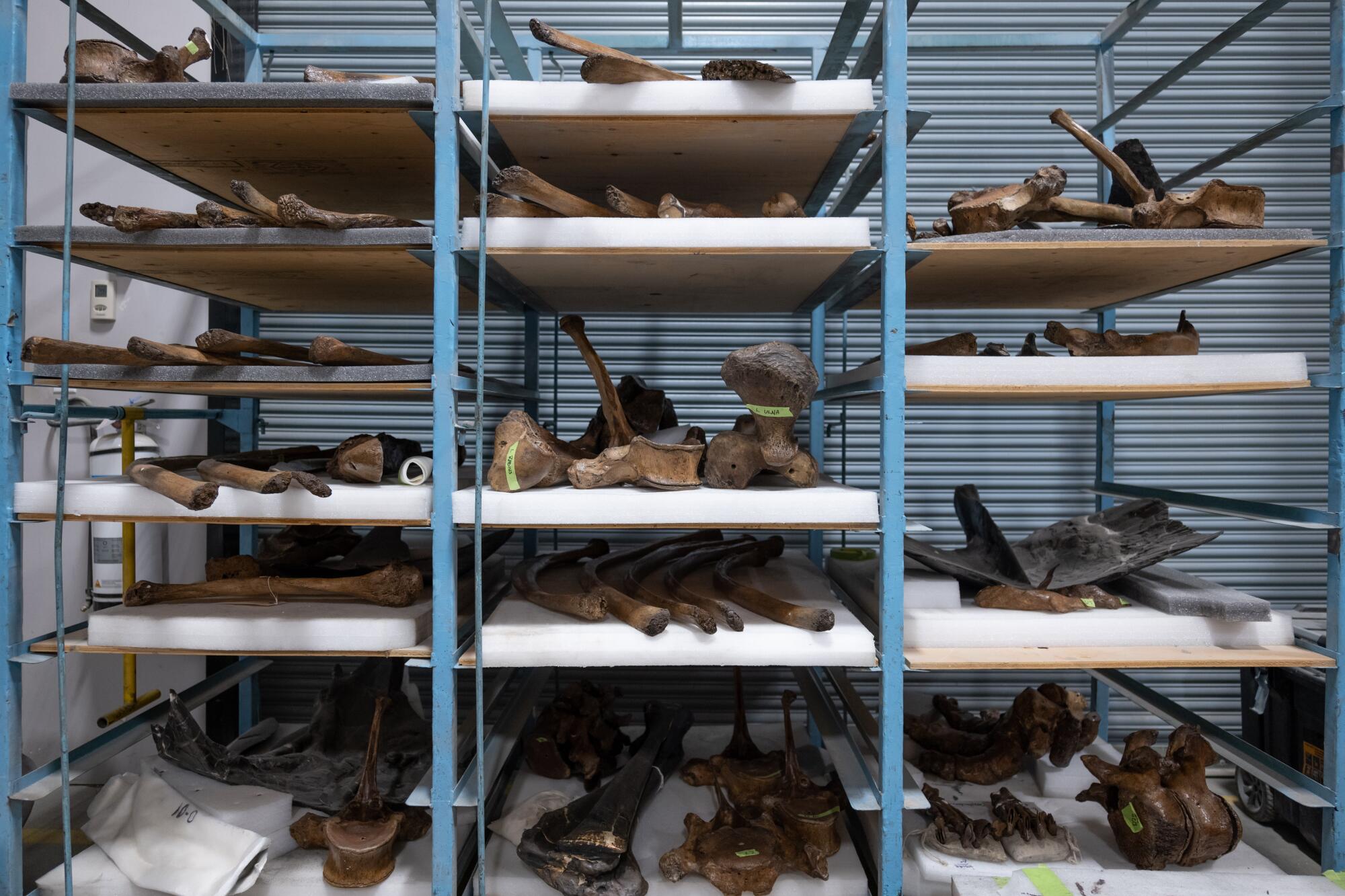
Dinosaurs are hardly ever found in their entirety, and this one is no exception. From a half-dozen fossil skeletons, paleontologists assemble a representative of the Gnatalie species, their best educated assumption of what the animal looked like. On a computer screen, the dinosaur’s internal architecture is put back together for the first time in millennia.
There are plans for this animal. The museum is opening a new welcome center, and the space needs something big and bold. The answer is right there in the prep lab — the world’s only green dinosaur skeleton.
Two hundred bones are packed in crates, each in its own custom foam cradle. They are loaded onto trucks with specialized suspension, and a fleet carrying priceless cargo begins the 2,600-mile journey north.
2022-2024: Trenton, Canada
Research Casting International’s unassuming warehouse sits on the bank of a quiet bay about 100 miles east of Toronto. Outside, beavers gnaw at the vegetation around the chilly waters. Inside is a steampunk fossil carnival.
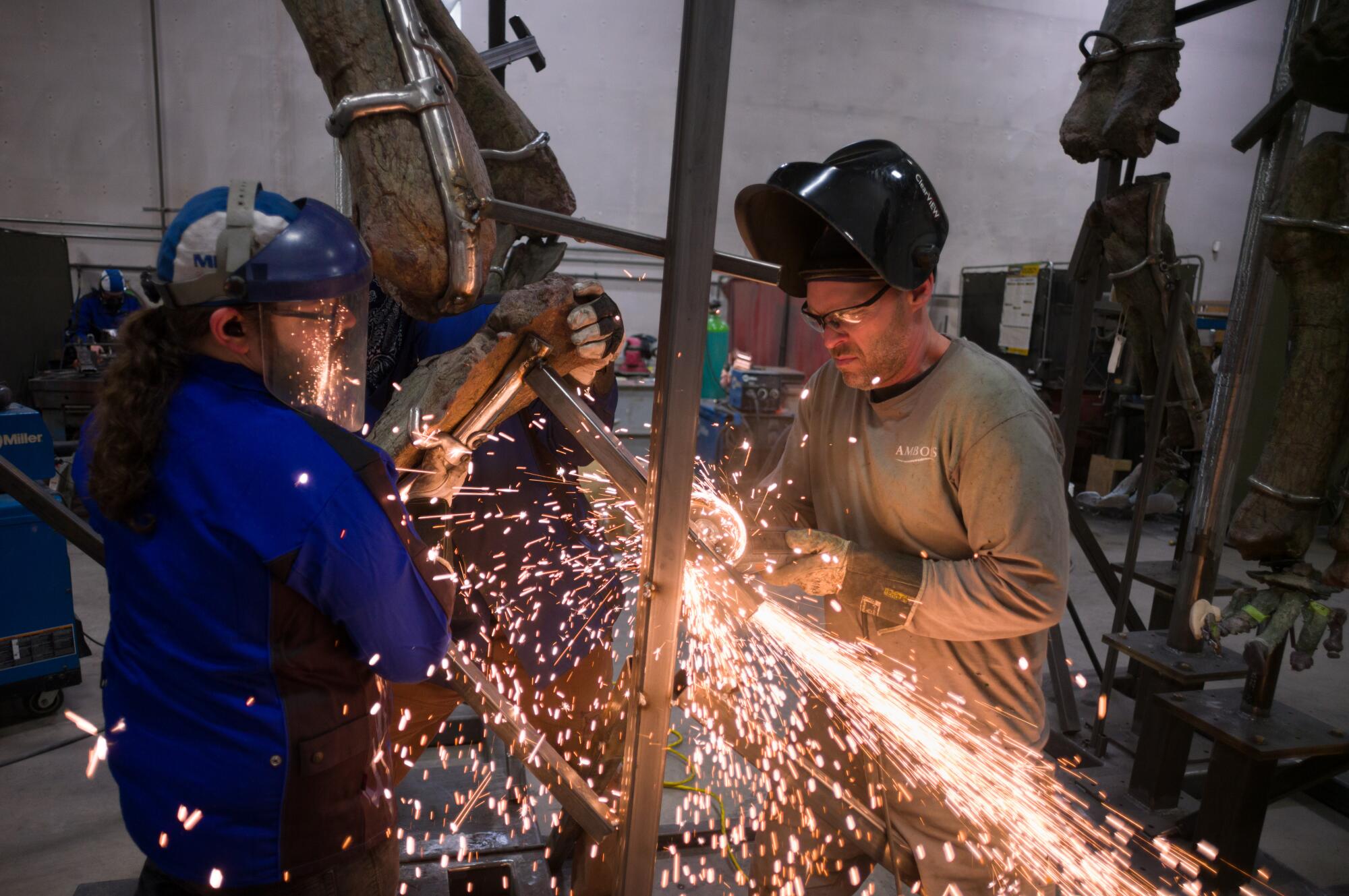
In one corner the lanky, headless skeleton of a Quetzalcoatl appears ready to take flight. Welding sparks fly nearby as a worker puts finishing touches on the joints in a replica T. rex toe.
The rearing barosaurus in the rotunda of New York’s American Museum of Natural History, the T. rex and triceratops locked in battle in the Natural History Museum’s main hall in L.A. — all of them first took form here in founder Peter May’s workshop.
And in the back of the cavernous warehouse, in a secure hangar, Gnatalie stands for the first time in 150 million years.
It’s 75 feet from nose to end, longer than the letters in the Hollywood sign are tall. A quirk in the fossilized sacrum, a bone in the lower back, means that the animal’s neck curves slightly to the left, giving the impression of a dinosaur turning its head curiously toward an unexpected sight.
1

2
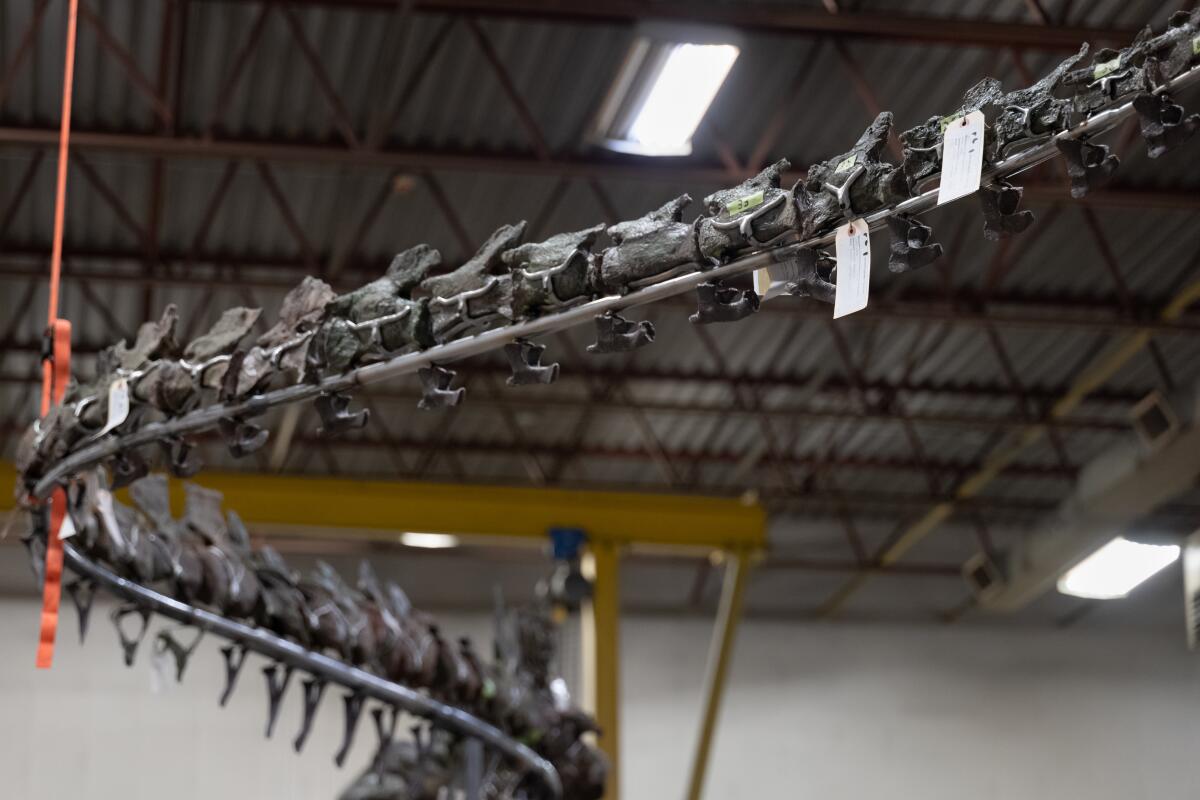
3

4

1. Custom metal reinforcements are fitted to dinosaur fossils. 2. The tail vertebrae of Gnatalie. 3. Mike Pyette prepares a temporary styrofoam skull for Gnatalie. 4. Paleontologist Luis Chiappe inspects “Natalie” at Research Casting International on March 4, 2023, in Trenton, Ontario, Canada. (Photos by Ian Willms/For The Times)
Hand-forged armatures connect some 350 bones to an underlying steel skeleton. Two-thirds are real fossils. The remainder are 3D-printed replicas of pieces nature didn’t preserve well, each hand-painted and textured to match the real bone.
As RCI employees walk through remaining work to be done on the mount, museum staff visiting from Los Angeles mark the location of the future hall’s entryway with painter’s tape on the warehouse floor.
Timelapse video of installation of the 75 feet long dinosaur on display at the Natural History Museum. (Natural History Museum)
“We want that jaw-dropping moment that compels you to want to learn more about the specimen,” says Chris Weisbart, associate vice president for exhibits.
The dinosaur will stand on a specially constructed platform that provides the public a better view and keeps the neck and tail beyond reach of overeager visitors tempted to jump up and touch it.
Nature makes most of the decisions about how a dinosaur mount will look, but there is a little room for interpretation within the realm of the scientifically plausible. At the moment, Chiappe, May and paleontologist Pedro Mocho are locked in an intense discussion about the precise positioning of an ulna. Chiappe carries a laptop around the front leg so that Mocho, watching via Zoom from his office in Lisbon, Portugal, can examine the bone.
“It’s a weird angle,” Mocho says finally. The leg needs adjusting.
“We have quite a lot of work to do,” Chiappe says, looking somewhat abashed.
“We have quite a lot of time,” May says with a smile.
2024: Los Angeles
On Sunday the Natural History Museum of Los Angeles County will open the long-awaited $75-million NHM Commons expansion.
Earlier in the year the museum asked the public to name their new dinosaur — not the species, which will get its scientific moniker when the long process of publishing the discovery is complete, but the mounted skeleton that people will come to visit, the green dinosaur that belongs to L.A. alone.
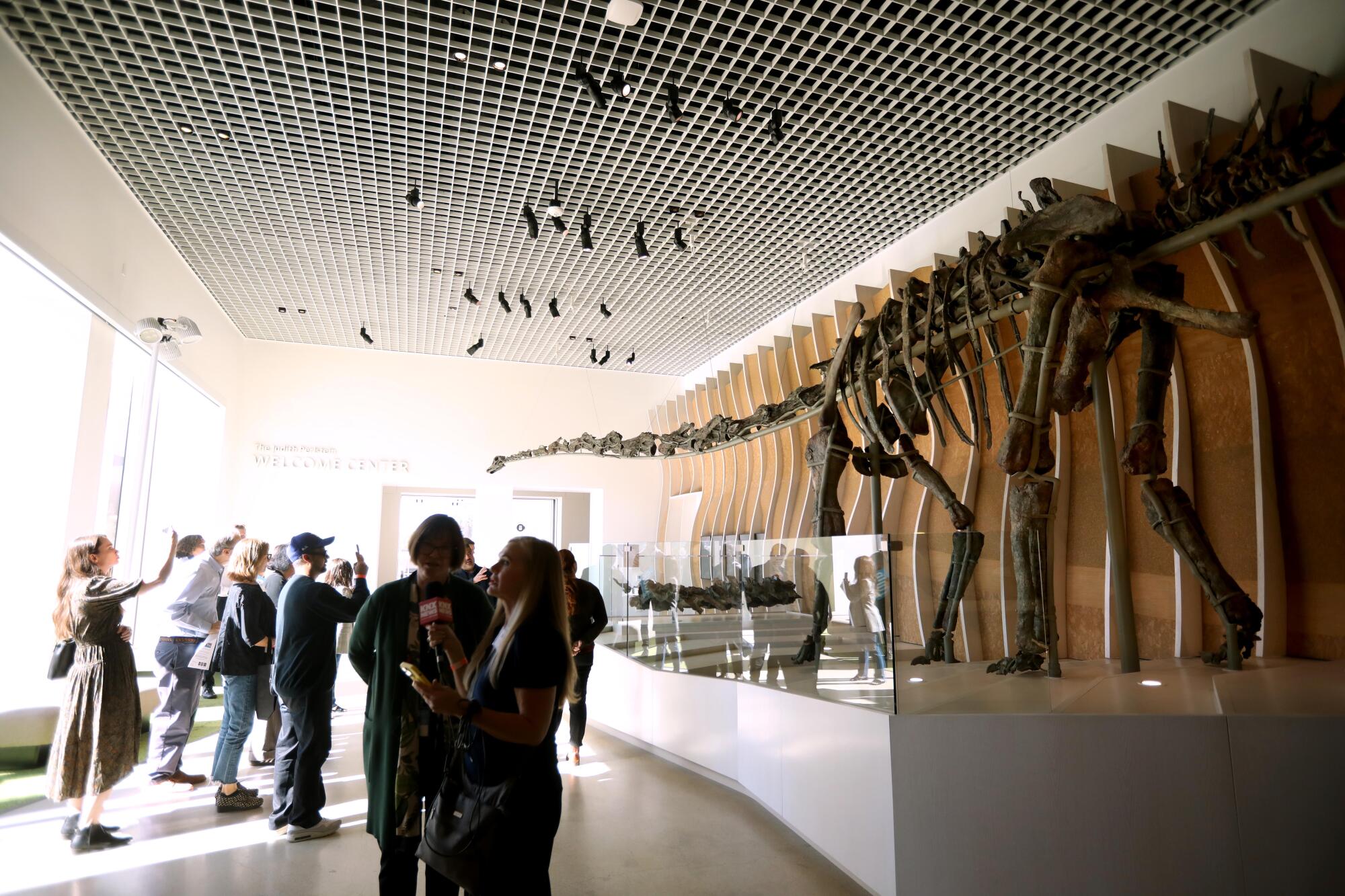
They threw out some options. Sage, for the native plant and earthy green color? Olive, a symbol of peace? Dinosaur enthusiasts voted to keep the name that stuck as soon as it came out of the Earth: Gnatalie.
Gnatalie will spend the rest of its fossilized existence welcoming visitors, its head arcing gently toward the windows, bony face turned toward the future Lucas Museum.
The height of the hall’s doors means that the shorter a visitor is, the better their perspective. Children coming to see the green dinosaur will gasp before their parents do. Small mammals will scamper at Gnatalie’s feet again.

